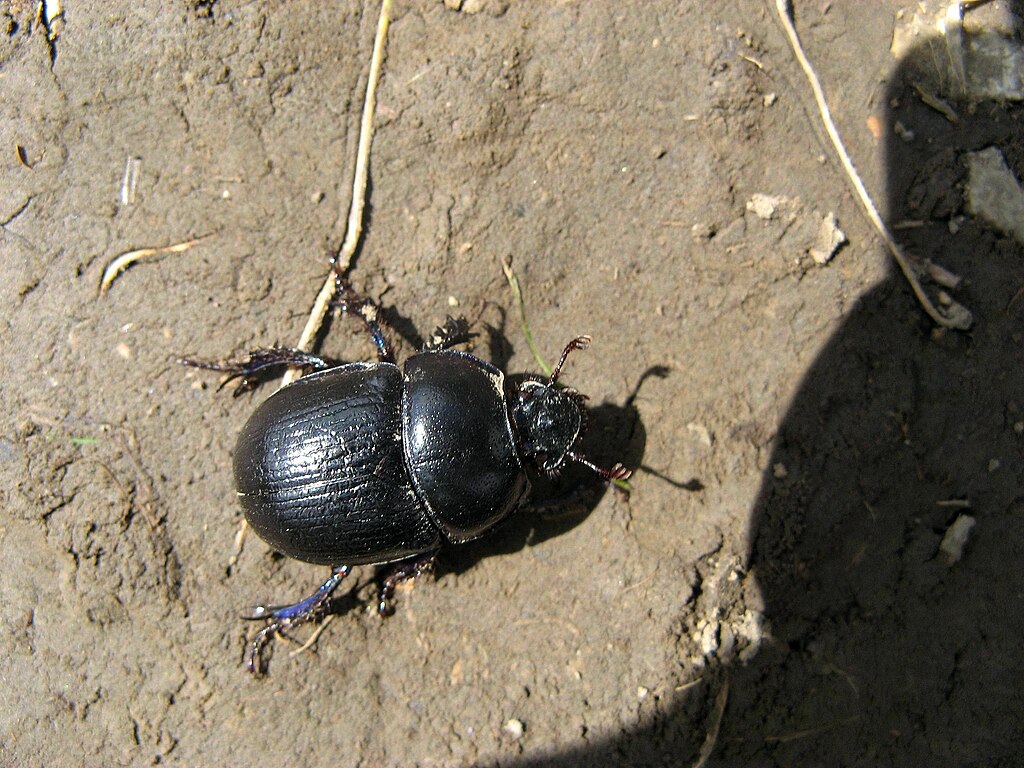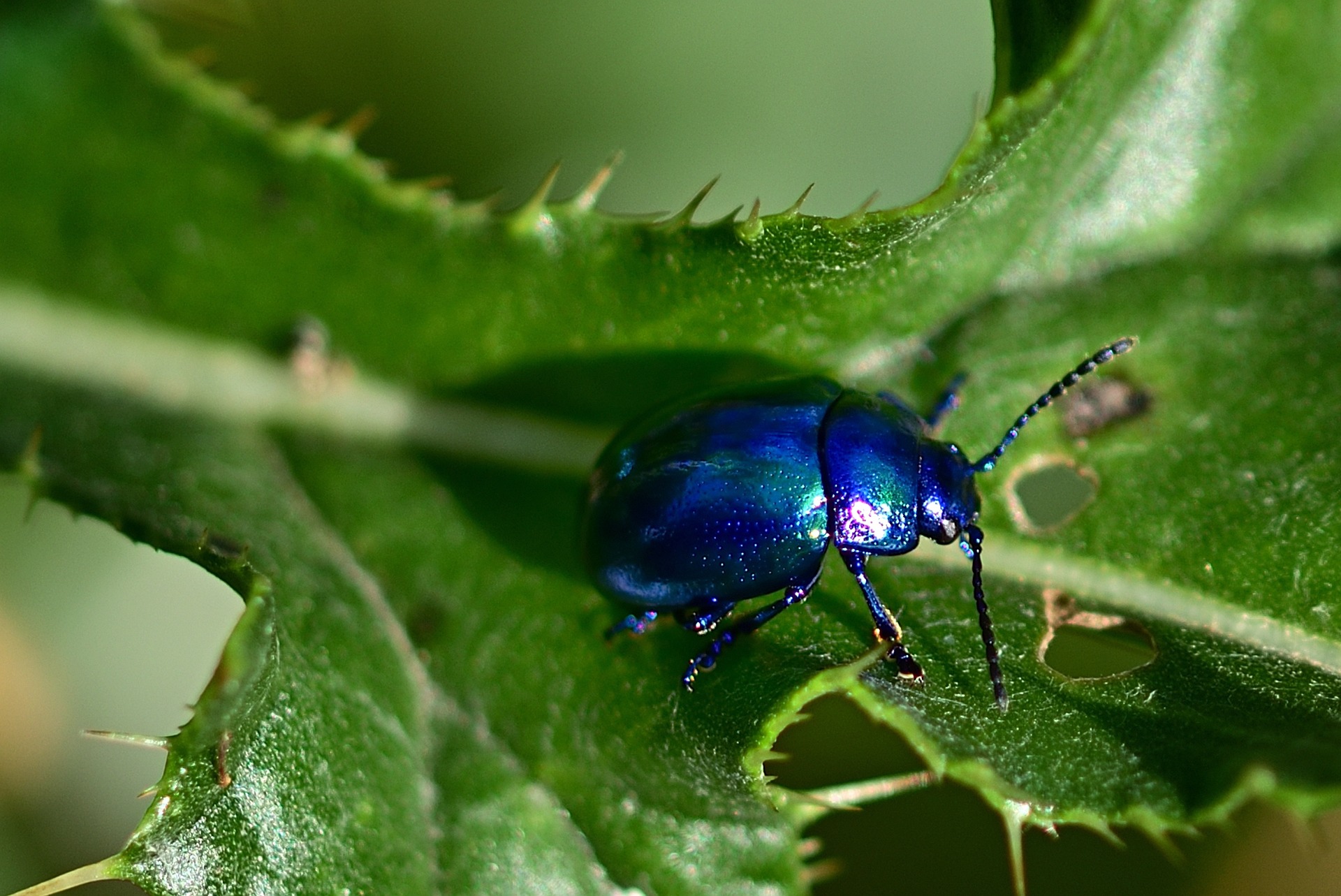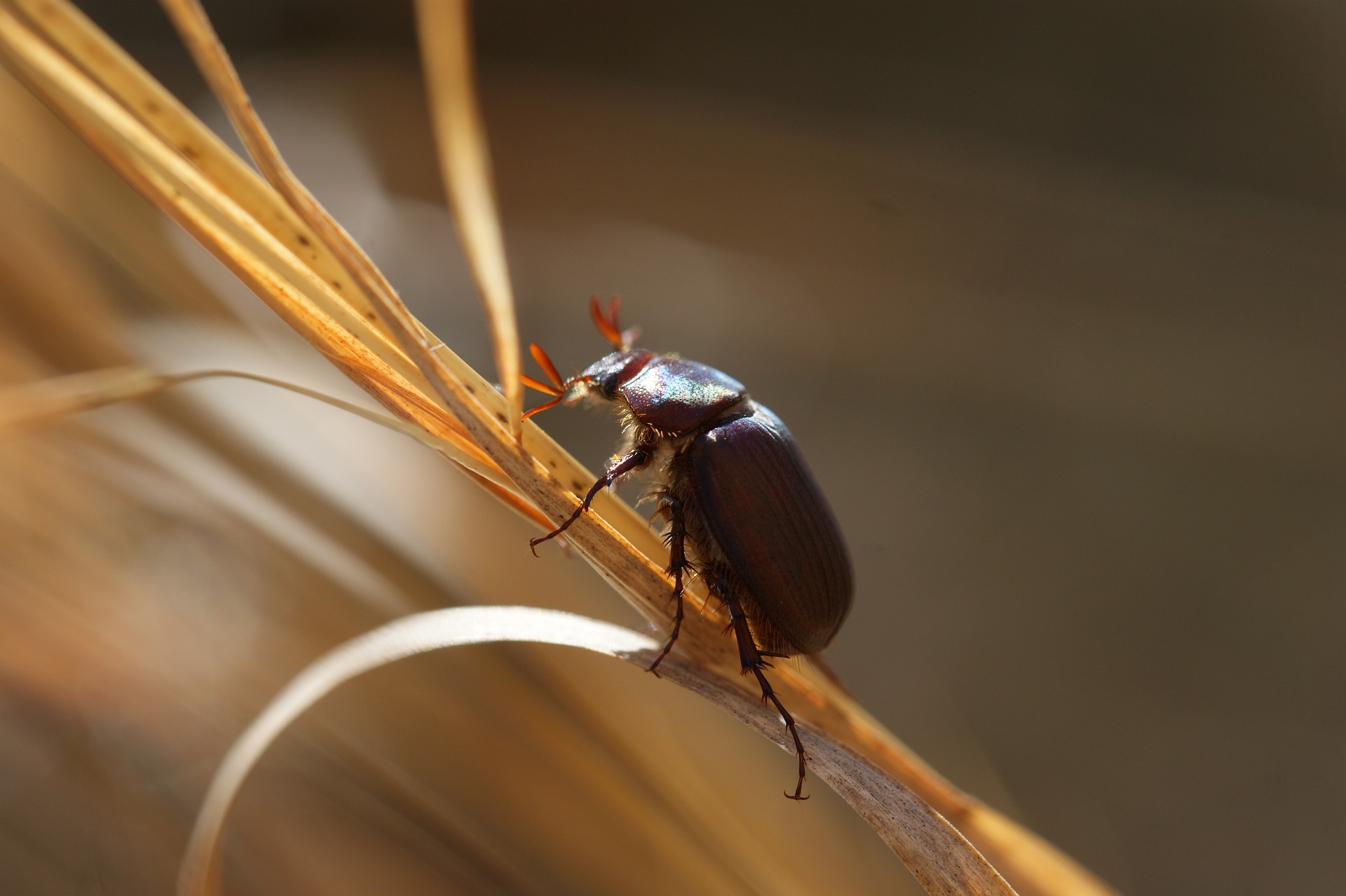American Spider Beetles
Often mistaken for spiders, American Spider Beetles have reddish-brown, rounded bodies with long legs and antennae. They inhabit human dwellings, mills, and warehouses, gravitating towards dried foods. In infested homes, their presence can cause food wastage. Their spider-like appearance makes them distinct from many other beetles.
Powderpost Beetles
These beetles have elongated, slender bodies and primarily infest hardwood. A hallmark of their activity is the powdery residue left behind in wood, alongside pin-sized exit holes. Their larvae cause significant damage to furniture, flooring, and structural timbers. They're named for the powdery wooden frass they create. Treatment for infestations often involves insecticides or fumigation.
Asian Long Horned Beetles
A distinctive feature of these beetles is their striking long antennae, combined with a black body adorned with white spots. Native to Asia, their introduction to North America has wreaked havoc on hardwood trees. Due to their extensive damage, numerous control and eradication programs have been initiated. These beetles lay their eggs in tree bark, and the larvae burrow deep, interrupting the tree's vascular system. Adult beetles feed on tree leaves and bark.
Billbugs
Billbugs are weevil-like beetles known to damage turfgrass. Signs of an infested lawn include brown patches because the larvae feed on grass roots. They have a snout-like projection, and their lifecycle involves multiple stages in the soil. An interesting fact is that adult billbugs don't fly, but instead, walk from one location to another. Their damage often gets mistaken for drought stress in lawns.
Blister Beetles
As their name suggests, these beetles release a chemical causing skin blisters upon contact. They vary in size and color but are often dark with softer elongated bodies. While they can be a threat to crops, their larvae play a beneficial role by preying on grasshopper eggs, helping control these potential pests. They have a unique defensive mechanism: when threatened, they release their toxic hemolymph. This chemical is called cantharidin and is even used medically to remove warts.
Carpet Beetles
These are small, oval beetles that can have a range of patterns and colors. They're notorious for damaging natural fibers in homes, consuming carpets, clothing, and upholstery. Their diet can also include animal products like wool, silk, leather, and pet hair. It's not just the adults; the larvae, often called "woolly bears," are particularly voracious feeders. A fascinating fact: while they're pests indoors, outdoors they pollinate flowers.
Cigarette Beetles
With their reddish-brown hue, Cigarette Beetles are known for infesting dried plant products, especially tobacco. These beetles have smooth, oval bodies and a humped appearance. Their ability to chew through packaging makes them a notable pest in pantries and stores. Apart from tobacco, they also feed on spices, rice, and dried flowers. Their name derives from their particular attraction to stored tobacco.
Citrus Longhorned Beetles
These beetles are sizeable with long antennae and black and white patterns on their bodies. They predominantly target citrus trees, posing a significant threat to citrus fruit farming industries. Native to Asia, they've become invasive in other parts of the world, requiring extensive pest control measures. Their larvae tunnel into tree trunks, causing extensive internal damage. Pheromone traps are often used in monitoring and controlling their populations.
Click Beetles
These beetles have elongated, sleek bodies. They derive their name from the unique clicking sound they produce when they jump to escape predators. This sound results from a spine on their belly snapping into a groove on their thorax. Although adults are relatively harmless, the larvae, known as "wireworms," can damage plants by feeding on seeds and roots. They're often attracted to lights at night.
Common Pine Shoot Beetles
As the name suggests, these beetles primarily target new shoots of pine trees. Small and brown, their activity can stunt tree growth and diminish a tree's overall health. They are considered pests in pine forests, impacting timber health and quality. An infested tree will have visible entry and exit holes with accompanying pitch tubes. Their lifecycle is closely intertwined with the health of pine trees.
Dried Fruit Beetles
These small beetles, with their smooth and shiny bodies, pose a threat to fruit industries. They not only consume dried fruits but also serve as vectors for fruit molds. Infestations can lead to significant economic losses due to food spoilage. An interesting note: these beetles can sometimes ferment fruit, causing it to produce alcohol. They have a particular fondness for overripe and damaged fruits.
Drugstore Beetles
Recognized by their cylindrical shape and tiny size, Drugstore Beetles are notorious pantry pests. They get their name from their tendency to infest medicinal herbs historically stored in drugstores. These beetles can chew through packaging, contaminating stored food products. A unique characteristic: they can feed on a wide variety of substances, including leather and books. Their larvae are known to bore into wood and other hard materials.
Elm Leaf Beetles
Primarily targeting elm trees, these beetles have a distinct yellow and black stripe pattern. Their feeding habits damage the leaves, causing them to dry and drop prematurely. This can weaken trees and make them susceptible to diseases. Cities with large elm populations can see significant tree losses. The larvae are especially damaging, skeletonizing the leaves, leaving only the veins behind.
Emerald Ash Borers
Characterized by their bright metallic green color, these beetles have devastated ash tree populations in North America. Native to Asia, they were discovered in the U.S. in the early 2000s. The larvae feed on the inner bark, disrupting the tree's ability to transport water and nutrients. Their rapid spread and severe damage have led to extensive research and control measures. Tens of millions of ash trees have already died due to this invasive pest.
European Spruce Bark Beetles
These tiny beetles pose a significant threat to spruce forests. They bore into the bark and lay eggs, and their feeding activity can lead to tree death. Outbreaks can result in considerable timber losses. These beetles have also been known to carry fungal diseases that further damage the trees. Climate change and warmer winters have been cited as factors contributing to larger beetle populations and increased damage.
Flour Beetles
Found globally, these beetles are common pests in stored grain products. Recognized by their reddish-brown color and tiny size, they predominantly feed on finely milled grain like flour. Infestations can lead to food spoilage and economic losses. They've been known to produce a foul odor, making infested food unpleasant. Interestingly, they can't feed on whole grains, only damaged grains and flour.
Foreign Grain Beetles
These beetles are drawn to areas with high humidity, often infesting newly constructed homes due to the moist wood. They feed on fungi growing on the wood, not the grain itself. While they're called grain beetles, their association with grain is somewhat misleading. The primary concern with these beetles is not food contamination but the sheer annoyance of their presence in homes. They're indicators of moisture problems in structures.
Furniture Beetles
Also known as woodworms, these beetles target wooden structures and furniture. Their larvae bore into wood, often going unnoticed until damage becomes extensive. They can weaken wooden structures over time, leading to significant repair costs. Telltale signs of their presence include exit holes and powdery residue. Older homes with hardwood are especially at risk from these beetles.
Ground Beetles
Among the most common beetles, they're beneficial predators that feed on pests like aphids and caterpillars. With over 2,000 species in North America alone, their size and color vary widely. They're mostly nocturnal and can often be seen around light sources at night. While they might startle with their size and speed, they're essential components of a healthy garden ecosystem. Some species are even used in agricultural fields for natural pest control.
Japanese Beetles
These metallic green and copper beetles are notorious pests in North America. They feed on the leaves of over 300 species of plants, skeletonizing the foliage. Originating from Japan, they were first identified in the U.S. in the 1910s. Their larvae, known as grubs, feed on plant roots and can damage turfgrass. One unique feature: they release pheromones to attract other beetles, leading to large feeding groups.
June Bugs
Often found in North America, these beetles have a shiny, reddish-brown exterior and are most active during late spring, hence their name. They're notorious for their loud flight and attraction to light. Their larvae, known as grubs, feed on plant roots, especially turfgrass, and can cause lawn damage. It's a common sight in certain regions to see birds, particularly crows, feasting on these grubs. These beetles are sometimes used as fishing bait due to their abundance.
Asian Lady Beetles
While they resemble the beneficial ladybugs, these beetles can be nuisances when they invade homes during colder months. Native to Asia, they were introduced to control aphids but became problematic due to their overwintering habits. When threatened, they excrete a foul-smelling liquid, staining surfaces. Their varied diet also means they sometimes prey on native ladybugs, potentially reducing their populations. Interestingly, their color can range from yellow to red, with varying numbers of spots.
Larder Beetles
Once a pest in dried meats, they're now more commonly found in stored products like pet food. Recognizable by their dark-colored body with a pale yellow band, they get their name from their preference for larders in the olden days. They can become household pests, feeding on a range of stored products. Their larvae have tiny spines and might bore into wood or even museum specimens.
Pantry Beetles
As the name suggests, these beetles are notorious pests of stored food products. They can infest grains, spices, and other pantry items. Regular inspection and proper storage are key to preventing their proliferation. While they don't pose a health risk, their presence indicates food contamination. Interestingly, their life cycle can be quite rapid, with several generations appearing in a single year if conditions are right.
Pine Bark Beetles
These tiny beetles are significant pests for pine trees. They bore into the bark, creating visible tunnels and potentially causing the death of the tree. The blue-stain fungi they carry further damages the trees. Infestations have been linked to drought conditions, as stressed trees are more susceptible. These beetles can have massive economic impacts, especially for the timber industry.
Plaster Beetles
They get their name from being commonly found in new plaster, but their actual diet is mold. These beetles appear in damp areas or newly constructed homes where walls haven't dried out completely. While not damaging to household items, their sheer numbers can be a nuisance. Their presence often indicates a moisture problem, which, if untreated, can lead to more significant issues in a home.
Sawtoothed Grain Beetles
Identified by the characteristic saw-like teeth on their prothorax, these beetles primarily infest grain products. They prefer processed food products like bran, oatmeal, and dried fruits. Their flat bodies allow them to easily penetrate food packaging. While they don't pose a direct health risk, infested food is considered contaminated. Intriguingly, they're known to be among the fastest-breeding grain beetles.
Shiny Spider Beetles
With a glossy and rounded appearance, these beetles often confuse many due to their spider-like look. They're typically found in dark, undisturbed areas and can become pests in stored products like grains or cereals. The "shiny" descriptor in their name comes from their gleaming, almost metallic appearance. They're also known to infest animal products like leather or museum specimens.
Stag Beetles
Famous for the large mandibles on males, resembling antlers, these beetles are a fascination for many. They primarily feed on decaying wood as larvae, playing a role in recycling organic material. Some species are even considered endangered due to habitat loss. Males use their mandibles for fighting and attracting females, making them a spectacle in the insect world.
Stink Beetles
These beetles, when threatened, can release a foul-smelling secretion, earning them their name. While they're not considered household pests, their odor can be quite off-putting. They mainly feed on decaying organic matter, aiding in decomposition. They play a role in the ecosystem by recycling nutrients. Despite their unpleasant odor, they're a vital part of the food chain.
Warehouse Beetles
Known as pests in stored grain products, Warehouse Beetles are a concern for both households and grain storage facilities. Recognizable by their oval shape and dark color, they're attracted to dry food sources like grains, cereals, and even animal-based products like dry pet food. Infestation is a sign of contamination, and the larvae can cause additional problems by producing hairs that may irritate the mouth, throat, and digestive tract if ingested.
White Marked Spider Beetles
Resembling small spiders due to their long legs and round body, these beetles are nocturnal and often found in dark, moist environments. Their preference for moldy food products and other decaying organic materials makes them occasional pests in homes and food storage areas. Whitemarked references the distinct pale marks on their otherwise dark bodies. Interestingly, these beetles are adept climbers and are often found scaling walls or ceilings.


